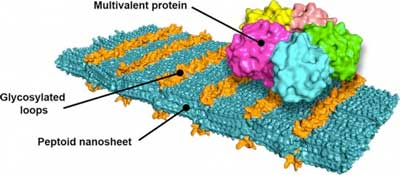| Jul 18, 2018 | |
Sugar-coated nanosheets selectively target pathogens(Nanowerk News) Can you catch viruses with designer flypaper? Researchers at the Molecular Foundry have developed a process for creating ultrathin, self-assembling sheets of synthetic materials that selectively bind with viruses, bacteria, and other pathogens (ACS Nano, "Glycosylated Peptoid Nanosheets as a Multivalent Scaffold for Protein Recognition"). |
|
 |
|
| A molecular model of a peptoid nanosheet shows loop structures of sugars (orange) that bind to the Shiga toxin (shown as a five-color bound structure at upper right). (Image: Berkeley Lab) | |
| This is the first time that nanostructures have been engineered with such sophistication that they approach the structural precision and complexity found in nature. The new method will enable materials that can selectively detect proteins, and potentially viruses and cells. The materials could find use in biosensors, therapeutics, or the bioremediation of threat agents. | |
| In nature, multivalency, or the ability to bind to multiple sites at once, is important for selective binding and plays a significant role in a variety of key biological processes such as guest-host recognition, cellular adhesion, and signal processing. Many infectious pathogens, such as virus and bacteria, specifically recognize host cells through multivalent interactions with sugars on the cell membrane to start the infection process. | |
| A team led by Molecular Foundry researchers has developed a method to create peptoid nanosheets that can selectively bind multivalent proteins, building on their past development of peptoid “molecular Velcro.” The researchers took advantage of the affinity of many proteins for carbohydrates and customized the surface of peptoid nanosheets with a variety of simple sugars. | |
| The research team combined atomic-level precision with a modular synthesis method to precisely engineer peptoid nanostructures. The result is a hydrophilic, stable, free-floating sheet that can be readily functionalized to resemble the surface of a cell. This is the first time that nanostructures have been created with such sophistication that they approach the structural precision and complexity found in nature. | |
| While there are other methods to synthesize multivalent compounds containing sugars, the products are generally heterogeneous and difficult to optimize because there is no structure-function relationship. Similarly, there are many 2-D nanomaterials, but they aren’t stable, free-floating, biocompatible, customizable, and easy to make. | |
| By using peptoids, rather than standard polymers, the researchers precisely controlled the monomer sequence and introduced specific modifications that dictate the final structure of the produced nanosheets, resulting in a customizable framework for recognizing sugar-binding proteins. The sugars were attached to the peptoid nanosheet using compounds of different lengths or within chemical “loops.” |
| Source: U.S. Department of Energy, Office of Science | |
|
Subscribe to a free copy of one of our daily Nanowerk Newsletter Email Digests with a compilation of all of the day's news. |
